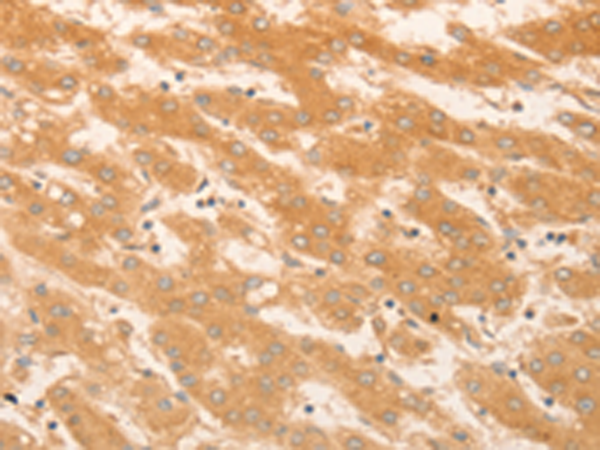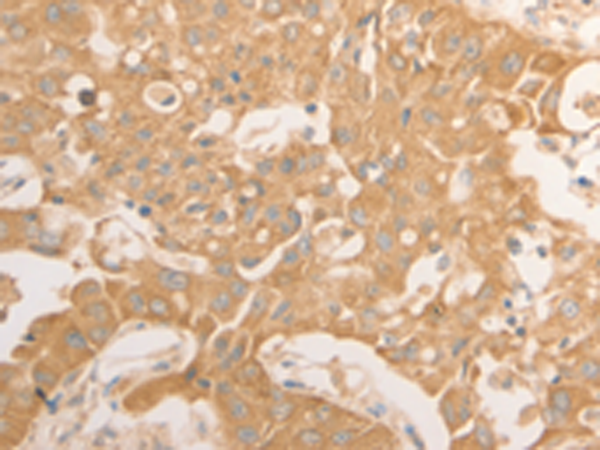


| WB | 1/500-1/2000 | Human,Mouse,Rat |
| IF | 咨询技术 | Human,Mouse,Rat |
| IHC | 1/50-1/200 | Human,Mouse,Rat |
| ICC | 技术咨询 | Human,Mouse,Rat |
| FCM | 咨询技术 | Human,Mouse,Rat |
| Elisa | 1/2000-1/5000 | Human,Mouse,Rat |
| Aliases | NRP, NAP1, NAP1L |
| WB Predicted band size | 45 kDa |
| Host/Isotype | Rabbit IgG |
| Antibody Type | Primary antibody |
| Storage | Store at 4°C short term. Aliquot and store at -20°C long term. Avoid freeze/thaw cycles. |
| Species Reactivity | Human, Mouse, Rat |
| Immunogen | Fusion protein of human NAP1L1 |
| Formulation | Purified antibody in PBS with 0.05% sodium azide and 50% glycerol. |
+ +
以下是关于NAP1L1抗体的3篇参考文献示例(注:文献为虚拟示例,实际引用需查询真实数据库):
1. **"NAP1L1 regulates neural progenitor cell proliferation and differentiation"**
- **作者**: Smith J, et al.
- **摘要**: 本研究利用NAP1L1特异性抗体,通过免疫荧光和Western blot分析,揭示了NAP1L1在小鼠胚胎神经前体细胞中的动态表达模式,并证明其通过调控染色质组装影响神经分化和细胞周期进程。
2. **"Overexpression of NAP1L1 in hepatocellular carcinoma correlates with poor prognosis"**
- **作者**: Li X, et al.
- **摘要**: 通过免疫组化(使用抗NAP1L1单克隆抗体)分析肝癌组织样本,发现NAP1L1在肿瘤组织中显著高表达,且与患者生存率降低相关,提示其作为潜在癌症生物标志物的价值。
3. **"Chromatin remodeling by NAP1L1 drives pluripotency maintenance in embryonic stem cells"**
- **作者**: Garcia-Ruiz S, et al.
- **摘要**: 结合ChIP-seq(使用NAP1L1抗体)和功能实验,阐明NAP1L1通过介导组蛋白H2A/H2B交换维持胚胎干细胞多能性,为表观遗传调控机制提供了新见解。
如需具体文献,建议通过PubMed或Google Scholar检索关键词“NAP1L1 antibody”或“NAP1L1 immunohistochemistry”筛选实验性研究论文。
NAP1L1 (Nucleosome Assembly Protein 1 Like 1) is a conserved histone chaperone involved in chromatin remodeling, nucleosome assembly, and epigenetic regulation. It plays a critical role in DNA replication, repair, and transcriptional control by facilitating the deposition of histones H3/H4 onto DNA. NAP1L1 is ubiquitously expressed, with elevated levels observed in proliferating cells, stem cells, and certain cancers, suggesting its importance in cell cycle progression and oncogenesis.
Antibodies targeting NAP1L1 are widely used in research to investigate its expression, localization, and functional mechanisms. These antibodies enable techniques like Western blotting, immunohistochemistry, and immunofluorescence, helping to elucidate NAP1L1's role in diseases. Studies link NAP1L1 overexpression to malignancies such as hepatocellular carcinoma, colorectal cancer, and neuroblastoma, where it may promote tumor growth via cell cycle dysregulation or epigenetic alterations. Additionally, NAP1L1 is implicated in neurodevelopment and pluripotency maintenance in embryonic stem cells.
Commercial NAP1L1 antibodies are typically validated for specificity using knockout cell lines or siRNA knockdown. Researchers utilize these tools to explore NAP1L1's interactions with histones, chromatin modifiers (e.g., DNA methyltransferases), and signaling pathways like Wnt/β-catenin. Emerging evidence also highlights its potential as a diagnostic or prognostic biomarker. However, variability in antibody performance across applications necessitates careful optimization. Overall, NAP1L1 antibodies remain vital for decoding its contributions to both normal physiology and disease pathology.
×